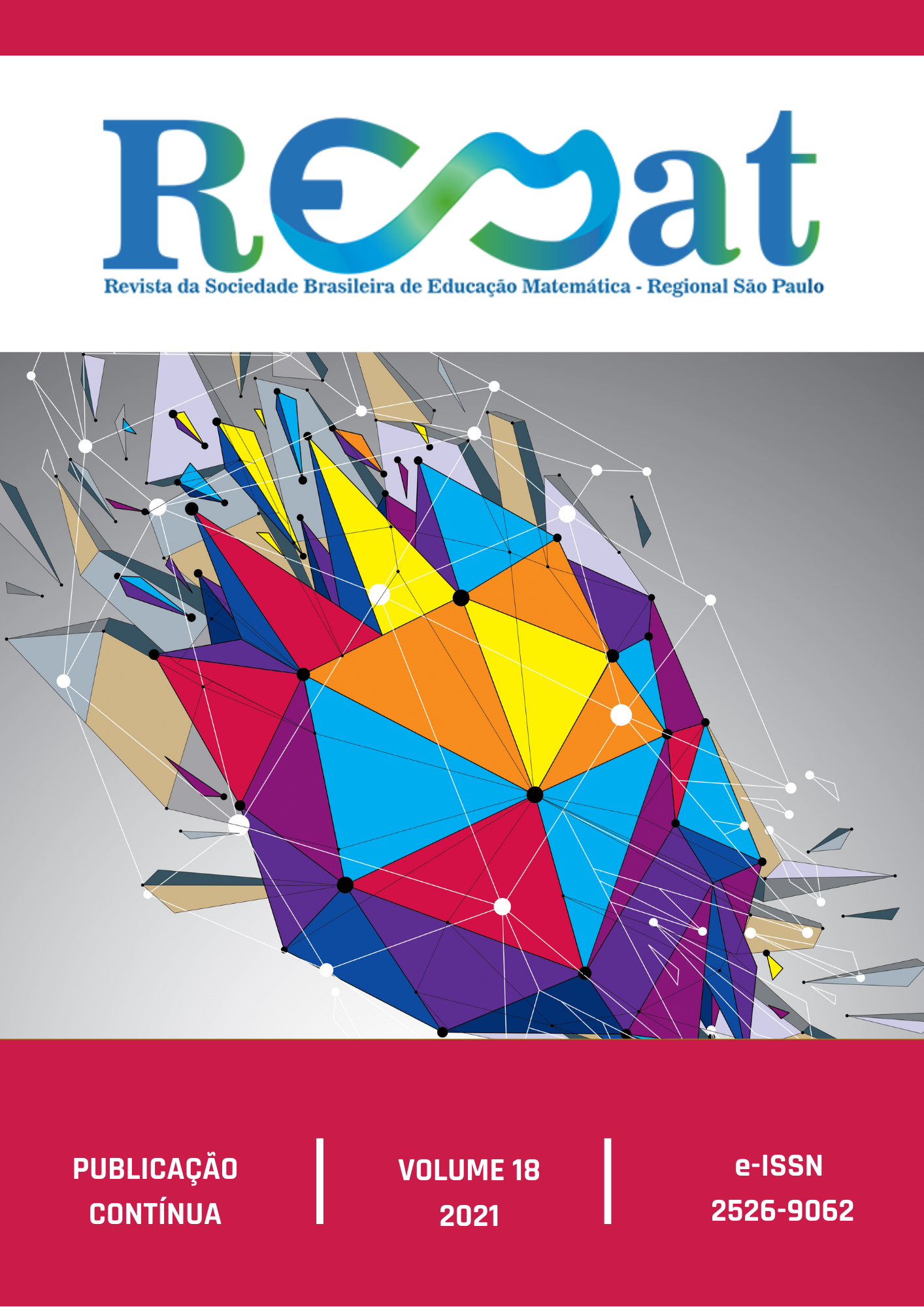Rational Number with Meaning of Fraction: relational aspect, ordering, equivalence and representations
DOI:
10.37001/remat25269062v18id521Keywords:
Teaching and Learning, Rational Number, FractionsAbstract
This article is about a research that aimed to analyze the process of teaching and learning the rational number, with the meaning of fractions, as well as their ordering and equivalence. 7th grade elementary school students, from a public school in São Paulo, who did not demonstrate understanding for any meaning of the rational number, experienced didactic-pedagogical activities, systematized to promote the development and coordination of competencies and skills associated with the rational number, such as: observe, perceive and understand. The activities were based on theoretical assumptions, considering the relational aspect for understanding a fraction and the role of semiotic representations in the development of mathematical concepts. The data of these activities were analyzed qualitatively in light of the theoretical framework of the research. According to the results, the use of the relational aspect for the concept of fraction and treatments and conversions between representations was fundamental for the elaboration of the meaning of the rational number as a fraction and for its ordering. However, for the concept of equivalence, the results presented by all students were diffuse, allowing inferring their non-consolidation given the conceptual non-permanence to the detriment of the fractions used and their representations. It is concluded that, for these students, the understanding of the rational number, with the meaning of the part-whole relationship and its ordering, was significantly elaborated considering the relational aspect and its representations.
Downloads
Metrics
References
BEHR, M., LESH, R., POST, T., & SILVER E. (1983). Rational Number Concepts. In: R. Lesh & M. Landau (Eds.). Acquisition of Mathematics Concepts and Processes. New York: Academic Press, 1983, p.91 – 125.
BROWN, B. The Relational Nature of Rational Numbers. Pythagoras, v. 36, n. 1, p. 1 – 8, 2015.
CISCAR, S.; GARCÍA, M. V. S. Fracciones. Madri-Espanha: Editorial Sintesis, 1988.
D’AMORE, B. Objetos, significados, representaciones semióticas y sentido. Relime, Número Especial, p. 177 – 195, 2006.
DUVAL, R. Registros de Representações Semióticas e Funcionamento Cognitivo da Compreensão Matemática. In: MACHADO, S. D. A. (Org). Aprendizagem em Matemática: registros de representação semiótica. Campinas: Papirus, 2010.
KIEREN, T. E. On the Mathematical, Cognitive, and Instructional Foundations of Rational Numbers. In R. Lesh (Ed.) Number and Measurement: Papers from a Research Workshop. ERIC, 1976.
MARANHÃO, M. C.; IGLIORI, S. B. C. Registros de Representação e Números Racionais. In: MACHADO, S. D.A. (Org). Aprendizagem em Matemática: registros de representação semiótica. Campinas: Papirus, 2010.
MCNIFF, J.; WHITEHEAD, J. Action Research: Principle and Practice. Routledge Falmer: London, 2002.
MELO, W. J. A.; TELES, R. A. de M. Conversões entre representações dos números racionais: análise de aspectos matemáticos e cognitivos com uso de material manipulável. Revista De Educação Matemática, 17, e020007, 2020. https://doi.org/10.37001/remat25269062v17id328
MISQUITTA, R. A Review of the Literature: Fraction Instruction for Struggling Learners in Mathematics. Learning Disabilities Research & Practice, v. 26, n. 2, p. 109–119, 2011.
MORETTI, M. O papel dos registros dos registros de representação na ação na aprendizagem de matemática. Contrapontos. v. 2, n. 6, p. 423 – 437, 2002.
PITKETHLY, A., HUNTING, R. A review of recent research in the area of initial fraction concepts. Educational Studies Mathematics, n. 30, p. 5–38, 1996. https://doi.org/10.1007/BF00163751
SÃO PAULO (ESTADO). Avaliação de Aprendizagem em Processo. Caderno do Professor. Avaliação Diagnóstica – 7º ano – ensino fundamental – Matemática. São Paulo: SEE, 2018.
SÃO PAULO (ESTADO). MATRIZES DE REFERÊNCIA PARA AVALIAÇÃO- DOCUMENTO BÁSICO. (SARESP). Secretaria da Educação: São Paulo, 2009. Disponível em http://file.fde.sp.gov.br/saresp/saresp2013/Arquivos/Matriz_Referencia_SARESP_basico_conteudo.pdf. Acesso em 09 de outubro de 2019.
SÃO PAULO (ESTADO) Secretaria da Educação. Currículo do Estado de São Paulo: Matemática e suas tecnologias. São Paulo: SE, 2011. Disponível em: https://midiasstoragesec.blob.core.windows.net/001/2019/06/aap-recomendaes-de-matemtica-7-ano-do-ef_2018_fev.pdf Acesso em: 12 de fevereiro de 2019.
SÃO PAULO (ESTADO). Secretaria da Educação. Relatório Pedagógico SARESP - Matemática. São Paulo: SEE, 2012.
VERGNAUD, G. Cognitive and Developmental Psychology and Research in Mathematics Education: some theoretical and methodological issues. For the Learning of Mathematics, v. 3, n. 2, p. 31 – 41, 1983. Disponível em http://flm-journal.org/Articles. Acesso em 31 de agosto de 2019.
VERGNAUD, G. A Criança, a Matemática e a Realidade. Curitiba: Editora da UFPR, 2009.
VERGNAUD, G. A Comprehensive Theory of Representation for Mathematics Education. Journal of Mathematical Behavior, v.17, n. 2, p. 167 – 181, 1998.
Downloads
Published
Métricas
Visualizações do artigo: 256 PDF (Português (Brasil)) downloads: 109 HTML (Português (Brasil)) downloads: 0 VISOR (Português (Brasil)) downloads: 0 EPUB (Português (Brasil)) downloads: 25
How to Cite
Issue
Section
License

This work is licensed under a Creative Commons Attribution-NonCommercial-NoDerivatives 4.0 International License.


 Português (Brasil)
Português (Brasil)
 Español (España)
Español (España)
 English
English






































